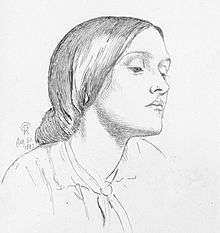John Hungerford Pollen (senior)
John Hungerford Pollen (1820–1902) was an English writer on crafts and furniture.
Life
He was educated at Eton College and Christ Church, Oxford.[1] He was ordained as an Anglican priest in 1845, with a parish in Leeds from 1847, writing of his experiences.[2][3]
He converted to Roman Catholicism in 1852.[4] He worked on numerous decorative projects in the 1850s, starting with the hall ceiling at Merton College, Oxford, where he was a Fellow from 1842; his conversion entailed his giving up that fellowship.[2]
Other works, mainly in collaboration, were on the University Museum in Oxford, and the Arthurian murals at the Oxford Union, in a group led by Dante Gabriel Rossetti and including William Morris, Edward Burne-Jones, Val Prinsep, and Roddam Spencer Stanhope.[5]
He worked with John Henry Newman on church architecture and decoration. He was responsible for the design of the Catholic University Church in Dublin. He also worked on the Brompton Oratory.[6][7] Newman invited him to take up a position at the Catholic University of Ireland, and Pollen was Professor of Fine Arts there, from 1855 to 1857.[8]
He returned to England in 1857, settling in Hampstead, London. He worked for The Tablet, and through John Everett Millais expanded his contacts with the Pre-Raphaelite circle.[9]
Later he worked for the South Kensington Museum, where he was appointed assistant keeper in 1863, and was made editor to its science and art department, producing catalogues.[2] He compiled, with Henry Cole, a Universal Catalogue of Books on Art. This was a multi-volume project, beginning publication in 1870, its aim being to furnish a complete bibliographical record of art books in libraries of the West.[10][11]
Works
- Letter to the Parishioners of St. Saviour's, Leeds (1851)
- Narrative of Five Years at St. Saviour's, Leeds (1851)
- A Description of the Trajan Column (1874) online text
- Ancient and modern Furniture and Woodwork (1876)
- Gold and Silver Smiths' Work
Family

Architect C. R. Cockerell was his uncle.[12] He married Maria Margaret La Primaudaye in 1855. As Maria Pollen, she was known as an author on lace.[13]
Of ten children, John Hungerford Pollen, Jesuit and writer, was his third child,[14] inventor Arthur Pollen was his sixth son.[15]
Further reading
- Anne Pollen (1920) John Hungerford Pollen, 1820–1902
| Wikisource has original text related to this article: |
Notes
- ↑ "The Most Trusted Place for Answering Life's Questions". Answers.com. Retrieved 24 February 2016.
- 1 2 3 Concise Dictionary of National Biography
- ↑ "The Oxford Movement. Vol. 12. The Romantic Revival. The Cambridge History of English and American Literature: An Encyclopedia in Eighteen Volumes". Retrieved 24 February 2016.
- ↑ "Archived copy". Archived from the original on 23 December 2008. Retrieved 9 October 2008.
- ↑ Carolyne Larrington, King Arthur's Enchantresses: Morgan and Her Sisters in Arthurian Tradition (2006, p. 157.
- ↑ "Archived copy". Archived from the original on 19 November 2008. Retrieved 9 October 2008.
- ↑ "'South Kensington' and the Science and Art Department". Retrieved 24 February 2016.
- ↑ Frederick O'Dwyer, The Architecture of Deane and Woodward (1997), p. 292.
- ↑ Dictionary of National Biography. Edited by Sidney Lee. Second Supplement. Volume 3. Neil – Young, article on Pollen.
- ↑ "Book collections". Archived from the original on 6 May 2010. Retrieved 24 February 2016.
- ↑ "National Art Library collection development policy: documentary materials". Archived from the original on 19 August 2009. Retrieved 24 February 2016.
- ↑ "Apps – Access My Library – Gale". Retrieved 24 February 2016.
- ↑ "Maria Pollen – The Online Books Page". Retrieved 24 February 2016.
- ↑ Christian Tapp (2005). "Pollen SJ, John Hungerford". In Bautz, Traugott. Biographisch-Bibliographisches Kirchenlexikon (BBKL) (in German). 24. Nordhausen: Bautz. cols. 1166–74. ISBN 3-88309-247-9.
- ↑ Jon Tetsuro Sumida, In Defence of Naval Supremacy: Finance, Technology and British Naval Policy, 1889–1914 (1993), p. 76.